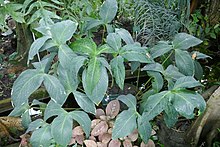
Spathiphyllum is a genus of about 60 species of monocotyledonous flowering plants in the family Araceae, native to tropical regions of the Americas and southeastern Asia. Certain species of Spathiphyllum are commonly known as spath or peace lilies.

Monstera is a genus of 59 species of flowering plants in the arum family, Araceae, native to tropical regions of central and south America.

Anubias is a genus of aquatic and semi-aquatic flowering plants in the family Araceae, native to tropical central and western Africa. They primarily grow in rivers and streams, but can also be found in marshes. They are characterized by broad, thick, dark leaves that come in many different forms. The genus was revised in 1979 and since then its nomenclature has been stable. Species can be determined by using mostly characteristics of the inflorescence. Because of the often shady places where the plants grow, the genus was named after the Egyptian god Anubis, the god of the afterlife. The genus was first described in 1857 by Heinrich Wilhelm Schott, with A. afzelii as its type species.

Cryptocoryne beckettii, also known as Beckett's water trumpet, is a plant species belonging to the Araceae genus Cryptocoryne.

Anubias barteri is a West African species of Anubias, first described in 1860 by Heinrich Wilhelm Schott. It occurs in south-eastern Nigeria, Cameroon and on Bioko.

Anubias barteri var. nana was first described by Adolf Engler in 1899 as A. nana. The species was reduced to varietal status in 1979.
Anubias gracilis is a plant that was first mentioned in 1920 by Chevalier and thereafter validly described by Hutchinson and Dalziel in 1936.
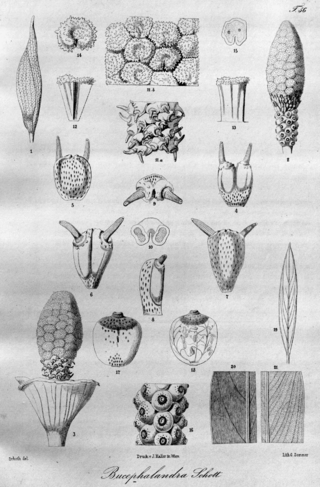
Bucephalandra is a genus of flowering plants in the family Araceae. There are 30 species of Bucephalandra which have been discovered in Borneo and have been formally described by S.Y. Wong and P.C. Boyce. Most of the species are found in Borneo. Bucephalandra are usually found growing as dense mats over stones or rocks in streams or rivers in moist tropical forest.

Lagenandra is a genus of aquatic flowering plants in the aroid family, Araceae, endemic to the Indian Subcontinent. The genus has gradually become more known through the aquascaping and aquarium hobby, in which several related Araceae genera are already highly prized and grown on a large scale ; Lagenandra, however, is still relatively rare in cultivation or private collections.
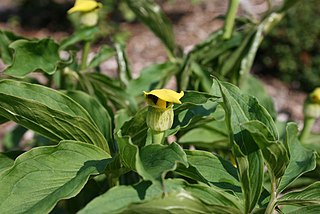
Arisaema flavum is a species of flowering plant widespread across north-eastern Africa and southern Asia. It is native to Ethiopia, Somalia, the Arabian Peninsula, Pakistan, Afghanistan, Nepal, Assam, Himalayas, Tibet, Yunnan, and Sichuan. The species epithet flavum is Latin for yellow and indicates its flower colour.

Thaumatophyllum bipinnatifidum is a plant in the genus Thaumatophyllum, in the family Araceae. Previously it was classified in the genus Philodendron within subgenus Meconostigma. The commonly used names Philodendron bipinnatifidum and Philodendron selloanum are synonyms. This plant is native to South America, namely to Brazil, Bolivia, Argentina, and Paraguay, but is also cultivated as a landscape plant in tropical, subtropical and warm temperate climates.
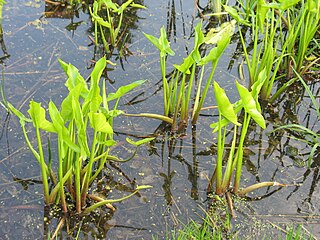
Peltandra virginica is a plant of the arum family known as green arrow arum and tuckahoe. It is widely distributed in wetlands in the eastern United States, as well as in Quebec, Ontario, and Cuba. It is common in central Florida including the Everglades and along the Gulf Coast. Its rhizomes are tolerant to low oxygen levels found in wetland soils. It can be found elsewhere in North America as an introduced species and often an invasive plant.

Pothos longipes is a climbing plant of the family Araceae native to the warmer rainforests of eastern Australia. It was first described in 1856 by the Austrian botanist Heinrich Wilhelm Schott. It ranges from Boorganna Nature Reserve in the Mid North Coast of New South Wales to tropical Queensland. It grows on the trunks of trees with a climbing or hemi-epiphytic habit. An attractive plant with interesting flowers and bright red fruit.
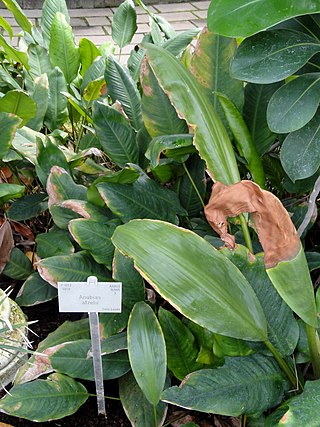
Anubias afzelii is a species belonging to the Aroid genus Anubias. It was first described scientifically by Heinrich Wilhelm Schott in 1857, based on material collected in Sierra Leone by Adam Afzelius, after whom the species was named. The genus Anubias was described simultaneously, with only A. afzellii belonging to it, which therefore is the type species of the genus. No other species currently placed in the genus Anubias was described earlier and A. afzelii was therefore the first species of this genus known to science.

Anubias heterophylla is a species belonging to the Aroid genus Anubias. It was first described scientifically by Adolf Engler in 1879.
Anubias barteri var. angustifolia was first described by Adolf Engler in 1915 as A. lanceolata f. angustifolia. The species obtained varietal status within A. barteri in 1979.

Anubias barteri var. caladiifolia was first described by Adolf Engler in 1915.
Anubias barteri var. glabra is a variety of A. barteri that was first described by N. E. Brown in 1901.
Anubias pynaertii is a species belonging to the Aroid genus Anubias. It was first described scientifically by Émile Auguste Joseph De Wildeman in 1910, based on material collected in Zaire by, among others, Léon Auguste Edouard Joseph Pynaert, after whom the species was named.

Anubias hastifolia is a species belonging to the Aroid genus Anubias. It was first mentioned by Adolf Engler in 1889 and described scientifically by him in 1893.
